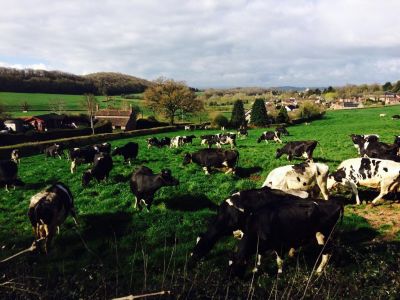
Posted By:
At Shepton and Wells Vets, we understand that every aspect of dairy cow management contributes to their well-being and productivity. As the days shorten and the nights lengthen, the topic of lighting provisions for dairy cows becomes increasingly vital. Often overlooked, lighting plays a crucial role in the overall yield and performance of dairy cows. While we diligently focus on elements like feed space, ventilation, and comfort, the impact of lighting on milk production can be profound and yet relatively simple to enhance.
As the clocks go back and the evenings draw in, dairy cow lighting provisions becomes more of a relevant topic.
There are several bottlenecks to cow yield and performance in dairy cow housing. We typically focus on feed space, ventilation, cubicle comfort and stocking density as we know these are related to lameness, ketosis, mastitis, fertility, and milk yields. Other problems such as heat stress which typically causes decreased intakes and therefore reduced milk yields can be hard to manage. Lighting is less commonly discussed but can be a relatively simple way to improve milk yields.
There were 10 studies between 1978 and 2002 which compared a natural light range of between 8 and 13.5 hours and an extended light range of 16-18 hours and they all found an increase in milk yield.
Unlike diet changes which can cause milk yield to change within a week, the response to increased light takes longer and is typically significant after 3-4 weeks of exposure.
In contrast to milking cows, dry cows benefit more from short or natural daylight hours when followed by long days, this allows them to re-set.
Continuous lighting when cows have 24 hours of light did not increase yield when compared to cows receiving 8.0-13.5 hours of natural daylight. It is important that cows get a rest period of darkness. For herds that do not want darkness for cow inspection etc red lights can be used, this light is not recognised by cows in the same way.
Milk composition is generally unaffected by increasing the length of daylight hours although slight depressions of milk fat percentage have been observed, this would be offset by the increased yield and therefore increased total milk fat.
Light can be measured using a Lux meter with a target of 150-200 Lux in the cubicles and feeding areas for 16 hours. You can also download Lux meter Apps for your mobile phone for a rough estimation.
- Vet Rob Powell
At Shepton and Wells Vets, we remain dedicated to exploring every avenue that enhances the health and productivity of your dairy herd. From our comprehensive studies and practical insights, we have learned the significance of proper lighting in dairy cow housing. By ensuring a balanced exposure to natural and extended light, with thoughtful consideration given to rest periods, we can positively influence milk yields. Through our commitment to understanding these nuances, we aim to provide your cows with an environment optimized for their well-being, ensuring both their health and your farm’s productivity flourish in harmony.
Whilst on my visits I have been having several discussions...
As our feline friends get older there are a few conditions...
Another winter discussion group season is now behind...
©2024 Shepton Veterinary Group Ltd., All rights reserved.
Privacy Policy • Terms & Conditions • Cookie Policy